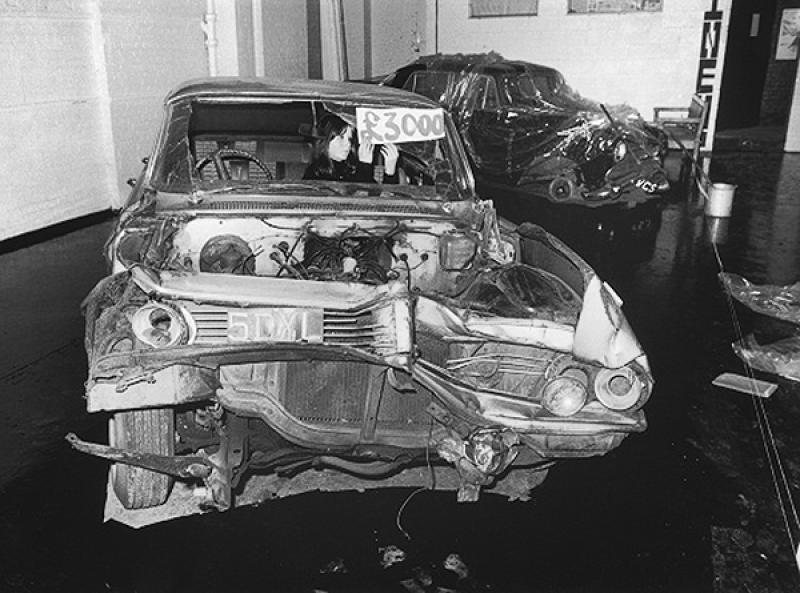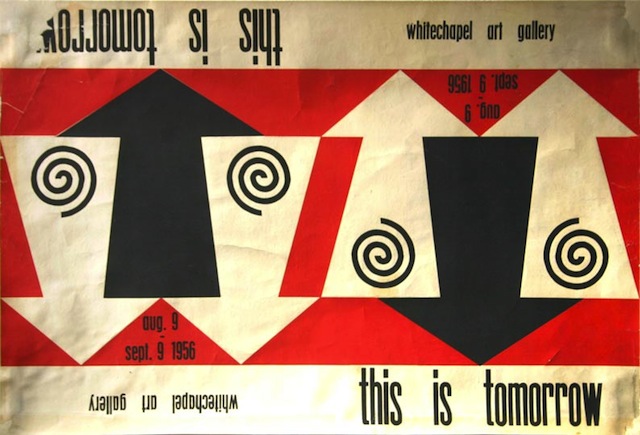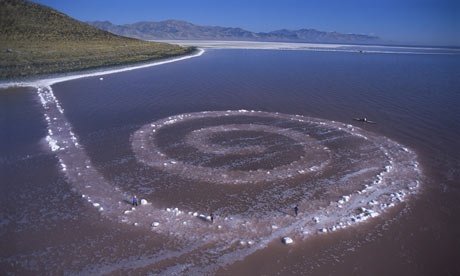Sci-Fi Week: Through the eyes of JG Ballard | reviews, news & interviews
Sci-Fi Week: Through the eyes of JG Ballard
Sci-Fi Week: Through the eyes of JG Ballard
The writer was profoundly influenced by art and in turn influenced artists

A sci-fi special would be incomplete without the profoundly influential figure of JG Ballard, a writer who, when he began his career in the late Fifties, fully subscribed to the notion that “sci-fi is the literature of the 20th century.” Unlike the “Hampstead novel,” he once said, “the sci-fi novel plays back the century to itself.”
But as much as he had embraced it, no one genre could really contain him. He was sui generis, and something of a visionary with it, acutely alive to the evolving hyper-real present and its dystopian possibilities. Environmental catastrophe, mass media, the fetishization of technology and consumerism, the physical, hyperrealised landscape of modernity – all these became for him urgent topics to address in fiction at a time when the British literary scene had barely noticed it was in the 20th century.
Like Ballard, Smithson was fascinated by the idea of entropy, and Ballard was in turn fascinated by Spiral Jetty
And his influence on other artists, particularly visual artists – unsurprising, since he himself was a profoundly cinematic writer – has been immense. Writing his obituary in 2009, Martin Amis wrote that Ballard had “very little interest in human beings in the conventional sense (and no ear for dialogue); he was remorselessly visual”.
It was the twinned inner “mindscapes” of Surrealism and psychoanalysis that made their enduring impact on Ballard very early on. He was drawn to the disquieting dreamscapes of De Chirico and Magritte and particularly to the highly eroticised paintings, with their somnambulant nudes and Freudian couplings of Eros and Thanatos, of Paul Delvaux. And when Ballard encountered British Pop art for the first time his excitement was considerable. He visited This is Tomorrow, the groundbreaking 1956 Whitechapel Gallery exhibition, featuring Eduardo Paolozzi and Richard Hamilton, and found that visual art was doing something British literary fiction wasn’t: it was addressing the world as it was being lived and experienced right now. (Pictured below: John McHale's This is Tomorrow exhibition poster)
 Ballard responded by making collages himself, connected to themes that were beginning to preoccupy him in his writing. Much later, in 1970, no doubt with Warhol's Car Crash screenprints of the early Sixties fresh in the mind, he organised an exhibition of crashed cars at London’s avant-garde New Arts Lab, simply called "Crashed Cars". The crushed vehicles were displayed without commentary and, as might have been anticipated, excited outraged responses and acts of vandalism. His novel Crash, in which the dark erotic impulse is tied to the pursuit of death in a car crash, followed in 1973.
Ballard responded by making collages himself, connected to themes that were beginning to preoccupy him in his writing. Much later, in 1970, no doubt with Warhol's Car Crash screenprints of the early Sixties fresh in the mind, he organised an exhibition of crashed cars at London’s avant-garde New Arts Lab, simply called "Crashed Cars". The crushed vehicles were displayed without commentary and, as might have been anticipated, excited outraged responses and acts of vandalism. His novel Crash, in which the dark erotic impulse is tied to the pursuit of death in a car crash, followed in 1973.
Ballard’s striking visual sensibility has, in turn, proved an enduring influence to many younger artists – from French artist Dominique Gonzlez-Forester, whose ninth Tate Modern Turbine Hall installation suggested a flooded, swampy post apocalypse in the middle of London (a nod to Ballard’s 1962 novel The Drowned World, among other science fiction scenerios) to British artist Marc Quinn’s prints of dizzyingly hyper-real, colour-saturated and lushly overgrown botanic gardens (naming one series Drowned World).
More directly, Tacita Dean’s 2013 film JG explored Ballard’s fascination with artist Robert Smithson, and was inspired by her correspondence with the writer in his last years. Their letters explored the connections between Smithson’s great earthwork Spiral Jetty, 1970, built on the north-eastern shore of Utah’s Great Salt Lake (pictured below; photo: George Steinmetz/Corbis), and Ballard’s short story The Voices of Time, published 10 years earlier, in which the main character builds a mandala in a dried saline landscape. The collection featuring this story was found among Smithson’s belongings after his death in a plane crash in 1973. Like Ballard, Smithson was fascinated by the idea of entropy, and Ballard was in turn fascinated by Spiral Jetty, though Ballard’s twin obsessions encompassed psychological as well as environmental disintegration.
 One might think of many other artists absorbed by Ballardian themes and ideas. Shortly after the writer’s death, a group show of Gagosian artists at Gagosian Britannia Street, including Ed Ruscha and the Chapman brothers among others, explored connections in homage to the late writer. But one artist whose work I think of more readily is Roger Hiorns’ Seizure, his glittering blue crystal growth overtaking the interior of an abandoned council flat in the Elephant and Castle. In Ballard’s 1966 post-apocalyptic novel The Crystal World, a mysterious force is mineralizing every surface of a jungle, including its animals. This eloquent environmental updating of the King Midas story seems poignantly fitting for an age in which anxiety and moral uncertainty haunt us.
One might think of many other artists absorbed by Ballardian themes and ideas. Shortly after the writer’s death, a group show of Gagosian artists at Gagosian Britannia Street, including Ed Ruscha and the Chapman brothers among others, explored connections in homage to the late writer. But one artist whose work I think of more readily is Roger Hiorns’ Seizure, his glittering blue crystal growth overtaking the interior of an abandoned council flat in the Elephant and Castle. In Ballard’s 1966 post-apocalyptic novel The Crystal World, a mysterious force is mineralizing every surface of a jungle, including its animals. This eloquent environmental updating of the King Midas story seems poignantly fitting for an age in which anxiety and moral uncertainty haunt us.
Share this article
Add comment
The future of Arts Journalism
You can stop theartsdesk.com closing!
We urgently need financing to survive. Our fundraising drive has thus far raised £49,000 but we need to reach £100,000 or we will be forced to close. Please contribute here: https://gofund.me/c3f6033d
And if you can forward this information to anyone who might assist, we’d be grateful.

Subscribe to theartsdesk.com
Thank you for continuing to read our work on theartsdesk.com. For unlimited access to every article in its entirety, including our archive of more than 15,000 pieces, we're asking for £5 per month or £40 per year. We feel it's a very good deal, and hope you do too.
To take a subscription now simply click here.
And if you're looking for that extra gift for a friend or family member, why not treat them to a theartsdesk.com gift subscription?
more Visual arts
 'We are bowled over!' Thank you for your messages of love and support
Much-appreciated words of commendation from readers and the cultural community
'We are bowled over!' Thank you for your messages of love and support
Much-appreciated words of commendation from readers and the cultural community
 Lee Miller, Tate Britain review - an extraordinary career that remains an enigma
Fashion photographer, artist or war reporter; will the real Lee Miller please step forward?
Lee Miller, Tate Britain review - an extraordinary career that remains an enigma
Fashion photographer, artist or war reporter; will the real Lee Miller please step forward?
 Kerry James Marshall: The Histories, Royal Academy review - a triumphant celebration of blackness
Room after room of glorious paintings
Kerry James Marshall: The Histories, Royal Academy review - a triumphant celebration of blackness
Room after room of glorious paintings
 Folkestone Triennial 2025 - landscape, seascape, art lovers' escape
Locally rooted festival brings home many but not all global concerns
Folkestone Triennial 2025 - landscape, seascape, art lovers' escape
Locally rooted festival brings home many but not all global concerns
 Sir Brian Clarke (1953-2025) - a personal tribute
Remembering an artist with a gift for the transcendent
Sir Brian Clarke (1953-2025) - a personal tribute
Remembering an artist with a gift for the transcendent
 Emily Kam Kngwarray, Tate Modern review - glimpses of another world
Pictures that are an affirmation of belonging
Emily Kam Kngwarray, Tate Modern review - glimpses of another world
Pictures that are an affirmation of belonging
 Kiefer / Van Gogh, Royal Academy review - a pairing of opposites
Small scale intensity meets large scale melodrama
Kiefer / Van Gogh, Royal Academy review - a pairing of opposites
Small scale intensity meets large scale melodrama
 Jenny Saville: The Anatomy of Painting, National Portrait Gallery review - a protégé losing her way
A brilliant painter in search of a worthwhile subject
Jenny Saville: The Anatomy of Painting, National Portrait Gallery review - a protégé losing her way
A brilliant painter in search of a worthwhile subject
 Abstract Erotic, Courtauld Gallery review - sculpture that is sensuous, funny and subversive
Testing the boundaries of good taste, and winning
Abstract Erotic, Courtauld Gallery review - sculpture that is sensuous, funny and subversive
Testing the boundaries of good taste, and winning
 Edward Burra, Tate Britain review - watercolour made mainstream
Social satire with a nasty bite
Edward Burra, Tate Britain review - watercolour made mainstream
Social satire with a nasty bite
 Ithell Colquhoun, Tate Britain review - revelations of a weird and wonderful world
Emanations from the unconscious
Ithell Colquhoun, Tate Britain review - revelations of a weird and wonderful world
Emanations from the unconscious
 Rachel Jones: Gated Canyons, Dulwich Picture Gallery review - teeth with a real bite
Mouths have never looked so good
Rachel Jones: Gated Canyons, Dulwich Picture Gallery review - teeth with a real bite
Mouths have never looked so good

Comments
Thank you for an insightful